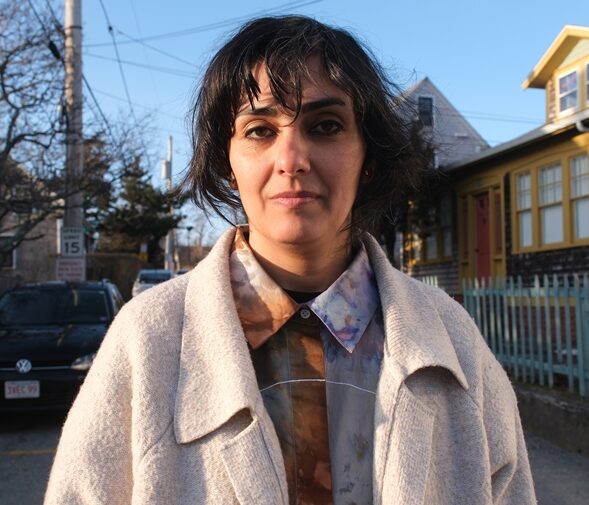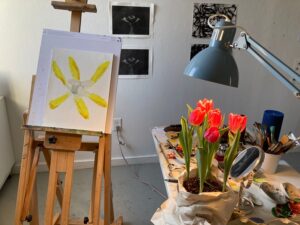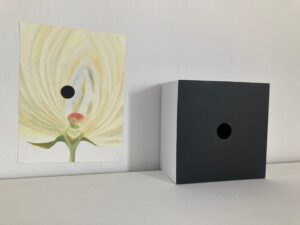Zeinab Shahidi Marnani’s studio on Pearl Street in Provincetown is dimly lit. In one corner sits a lounge chair with yellow pillows on it. A desk in the middle of the room is covered with clamshells painted with streaks of blue, red, and green. A book of Persian poetry lies on a side table; drawings of the moon cover many surfaces; bouquets of flowers sit in vases beside a printout of an etching of a camera obscura.

A series of shoeboxes are in one corner of the studio. The boxes are cardboard prototypes of Shahidi’s newest work. If you lift them up and gaze through the two holes cut in each box’s surface, you will observe a small white circle cut from paper inside the box. Try crossing your eyes, she suggests, or focus on the slits cut into the box, or ignore the slits and focus just on the circle.
Next to the shoeboxes is a piece of paper with a diagram of possible images that might arise as you warp your gaze. If you focus hard enough, you can try to conjure all the tricks of the eye listed there. You might see the circle blur and become two, or you might find that an imagined black circle hovers over the circle’s middle.
“There were moments when I realized I’m not even breathing, because I was trying to focus my eyes so much,” says Shahidi, one of this winter’s visual arts fellows at the Fine Arts Work Center. Her work will be on display at FAWC on Friday, March 8 from 5 to 8 p.m. in a group showcase with visual arts fellow Micha Patiniott and writing fellows Jack Eley and Grace Chao.
Shahidi makes art about the act of seeing: the way that light can trick you and the way that your own eyes can trick you. She does not work in one particular medium, instead roaming across documentary, sculpture, and, most recently, painting. The central feature of her work is that it turns the moment of encountering art into an experiment. It becomes a way to test your perspective.
Shahidi was born in 1983 in Esfahan, a city in central Iran. Provincetown has brought up many childhood memories, possibly because of “the nature or the isolation of the winter,” she says. She describes a memory of loving the color yellow at age 9 or 10 and believing that it held all light. She would lay a rainbow of colored pencils down and take the yellow one away, she says, laughing. The other colors looked unimpressive without it.
Shahidi studied visual communications at the University of Tehran but took many courses in the philosophy department. “I was so touched by what I learned there and didn’t expect to read such things,” she says. In particular, she loved Heraclitus. “It doesn’t sound like philosophy; it sounds more like poetry.”
After college, Shahidi began showing work in European galleries, including sculptures made for her undergraduate thesis. In 2009, she enrolled at Yale to study sculpture and began working with video there. Since then, Shahidi has alternated living in Tehran and New York.

Shahidi’s work makes you more aware of the experience of perception: “What you decide to see is what you see,” she says. Simply sitting through beginner physics classes and learning how vision works, how light bends, and what sits beyond the night’s darkness, does not necessarily lead to noticing these phenomena in daily life. There’s knowing something, and then there’s experiencing it.
An earlier work of Shahidi’s, a documentary project titled Soliloquy, posed these questions in tangible terms. In each video, a different artist sits before a camera and describes a project that the artist is working on. After a period of time, the artists were asked to watch the previous videos of themselves, pausing them when they wanted to amend the description or talk about changes in their work.
The process of correcting their previous works was also filmed, collaged into the video, and repeated several times. These videos unearth what happens when you’re alone in a room making art. They map the timeline of an artist’s project from its beginning through its development to the time that viewers encounter the work. By asking how a single work of art can bear an endless variety of experiences and perceptions, the project mirrors the themes that run through Shahidi’s recent work about sight and vision.
An essential part of her process is stepping away from the work and allowing questions and ideas to arise naturally. “Sometimes, when you have a strong feeling about something, it’s more about the time that you spend questioning it,” she says. “With art, I question it every second. I ask, ‘Why should I even do this?’ and I take a break. Which is good for art, because it’s not just a career — it’s good to say no when you don’t have the intuition to make something.”

For the last seven years, Shahidi has worked as a researcher for an art collector in New York, requiring frequent travel to Central Asia to learn about suzani embroidery. An artist draws a design on the fabric, and others stitch it into place, says Shahidi. The textiles are often made specially for a woman’s wedding day. There is no plan for the design, though there are certain important symbols; instead, the artist draws from divine intuition.
One symbol that recurs in the fabrics is an open flower. The flower is “the heart of the person, how they feel inside,” Shahidi says. “They think that god is inside you, closer to yourself,” rather than something or someone you have to seek out beyond yourself.
That turning toward the body and the self for answers is at the heart of Shahidi’s work. But the artist doesn’t call it mystical. “Mystics were looking for something divine,” she says. “I’m not looking to find anything.”
And yet the art does work a certain kind of magic on our sight. “It’s magic when two becomes one,” says Shahidi, “when you have two elements in front of you, but you see just one.”
See and Be Seen
The event: A showcase with FAWC fellows Grace Chao, Jack Eley, Zeinab Shahidi Marnani, and Micha Patiniott
The time: Friday, Mar. 8, 5 to 8 p.m.
The place: Fine Arts Work Center, 24 Pearl St., Provincetown
The cost: Free



